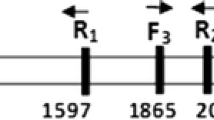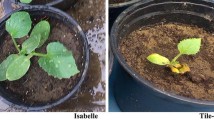Abstract
The inheritance of the resistance to Fusarium oxysporum f. sp. melonis (F.o.m.) races 0 and 2 in ‘Tortuga’, a Spanish cantalupensis accession, was studied from crosses of ‘Tortuga’ by the susceptible line ‘Piel de Sapo’ and the resistant one ‘Charentais-Fom1’ that carries the resistance gene Fom-1. The segregation patterns observed in the F2 (‘Tortuga’ × ‘Piel de Sapo’) and the backcross (‘Piel de Sapo’ × (‘Tortuga’ × ‘Piel de Sapo’) populations, suggest that resistance of ‘Tortuga’ to races 0 and 2 of F.o.m. is conferred by two independent genes: one dominant and the other recessive. In the F2 derived from the cross between accessions ‘Tortuga’ and ‘Charentais-Fom1’, the lack of susceptible plants indicated that the two accessions are carrying the same resistance gene (Fom-1). The analysis of 158 F2 plants (‘Tortuga’ × ‘Piel de Sapo’) with a Cleaved Amplified Polymorphic Sequence marker 618-CAPS, tightly linked to Fom-1 (0.9 cM), confirmed that ‘Tortuga’ also carries a recessive gene, that we propose to symbolize by fom-4.

Similar content being viewed by others
References
Álvarez JM, González-Torres R, Mallor C, Gómez-Guillamón ML (2005) Potential sources of resístanse to Fusarium wilt and powdery mildew in melons. Hortscience 40:1657–1660
Banihashemi Z, DeZeeuw DJ (1975) The behavior of Fusarium oxysporum f. sp. melonis in the presence and absence of host plants. Phytopathology 65:1212–1217
Baudracco-Arnas S, Pitrat M (1996) A genetic map of melon (Cucumis melo L.) with RFLP, RAPD, isozyme, disease resistance and morphological markers. Theor Appl Genet 93:57–64
Brotman Y, Kovalski I, Dogimont C, Pitrat M, Portnoy V, Perl-Treves R (2005) Molecular markers linked to papaya ring spot virus resistance and Fusarium race 2 resistance in melon. Theor Appl Genet 110:337–345
Buschges R, Hollricher K, Panstruga R, Simons G, Wolter M, Frijters A, van Daelen R, van der Lee T, Diergaarde P, Groenendijk J, Topsch S, Vos P, Salamini F, Schulze-Lefert P (1997) The barley Mlo gene: a novel control element of plant pathogen resistance. Cell 88:695–705
Champaco ER, Martyn RD, Miller ME (1992) Evaluation of muskmelon germplasm for resistance to Fusarium wilt. Subtrop Plant Sci 45:39–42
Chupp C (1930) Fusarium wilt of muskmelon. Plant Dis Rep 14:160
Ferreira JJ, Rodríguez C, Pañeda A, Giraldez R (2003) Allelism test for resistance to race 38 of anthracnose in common bean differential cultivar, ‘Widusa’. Annu Rep Bean Improv Coop 46:169–170
Freeman S, Rodriguez RJ (1993) A rapid inoculation technique for assessing pathogenicity of Fusarium oxysporum f. sp. niveum and F. o. melonis on cucurbits. Plant Dis 77(12):1198–1201
Gamborg OL, Wetter LR (1975) Plant tissue culture methods. National Research Council of Canada, 109 pp
Gómez-Guillamón ML, López-Sesé AI, Sarria E, Yuste-Lisbona FJ (2006) Linkage analysis among resistances to powdery mildew and virus transmission by Aphis gossypii Glover in melon line “TGR-1551”. In: Holmes GJ (ed) Proceedings Cucurbitaceae, 17–21 Sept 2006. Universal Press, Raleigh, NC, USA, pp 100–107
Hall TA (1999) BioEdit: a user-friendly biological sequence alignment editor and analysis program for Windows 95/98/NT. Nucleic Acids Symp Ser 41:95–98
Khetarpal RK, Maisonneuve B, Maury Y, Chalhoub B, Dinant S, Lecoq H, Varma A (1998) Breeding for resistance to plant viruses. In: Hadidi A, Khetarpal RK, Koganezawa H (eds) Plant virus disease control. The American Phytopathological Society, St. Paul, USA, pp 14–32
Kosambi DD (1944) The estimation of map distance from recombination values. Ann Eugen 12:172–175
Lander ES, Green P, Abrahamson J, Barlow A, Daley MJ, Lincoln SE, Newberg L (1987) MAPMAKER: an interactive computer package for constructing primary genetic linkage maps of experimental and natural populations. Genomics 1:174–181
Leach JG, Currence TM (1938) Fusarium wilt of muskmelons in Minnesota. Minn Agric Exp Stn Tech Bull 129:32
McDonald BA, Linde C (2002) Pathogen population genetics, evolutionary potential, and durable resistance. Annu Rev Phytopathol 40:349–379
Michelmore RW (2003) The impact zone: genomics and breeding for durable disease resistance. Curr Opin Plant Biol 6:397–404
Oliver JL, Garcia-Mas J, Cardús M, Pueyo N, López-Sesé AI, Arroyo M, Gómez-Paniagua H, Arús P, de Vicente CM (2001) Construction of a reference linkage map of melon. Genome 44:836–845
Oumouloud A, Arnedo-Andrés MS, Gónzalez-Torres R, Álvarez JM (2008) Development of molecular markers linked to the Fom-1 locus for resistance to Fusarium race 2 in melon. Euphytica 164:347–356
Oumouloud A, Arnedo-Andrés MS, Gónzalez-Torres R, Álvarez JM (2009) Morphological and molecular characterization of melon accessions resistant to Fusarium wilts. Euphytica 169:69–79
Pitrat M, Risser G, Bertrand F, Blancard D, Lecoq H (1996) Evaluation of a melon collection for disease resistances. In: Gómez-Guillamón ML, Soria C, Cuartero J, Torés JA, Fernández-Muñoz R (eds) Cucurbits towards 2000. Proceedings of the VIth eucarpia meeting on cucurbit genetics and breeding, 28–30 May 1996. Málaga-Spain, pp 49–58
Risser G (1973) Étude de l’héredité de la résistance du melon (Cucumis melo) aux races 1et 2 de Fusarium oxysporum f.sp. melonis. Ann Amél Plantes 23:259–263
Risser G (1987) Controversy on resistance to Fusarium wilt in ‘Perlita’ (Cucumis melo L.). Cucurbit Genet Coop Rep 10:60–63
Risser G, Banihashemi Z, Davis DW (1976) A proposed nomenclature of Fusarium oxysporum f. sp. melonis races and resistance genes in Cucumis melo. Phytopathology 66:1105–1106
Sherf AF, MacNab AA (1986) Fusarium wilt of muskmelon. In: Vegetable diseases and their control, 2nd edn. John Wiley, New York, pp 334–337
Yuste-Lisbona FJ, López-Sesé AI, Gómez-Guillamón ML (2009) Inheritance of resistance to races 1, 2 and 5 of powdery mildew in the melon TGR-1551. Plant Breed. doi:10.1111/j.1439-0523.2009.01655.x
Zink FW, Gubler WD (1985) Inheritance of resistance in muskmelon to Fusarium wilt. J Am Soc Hort Sci 110:600–604
Zink FW, Gubler WD, Grogan RG (1983) Reaction of muskmelon germplasm to inoculation with Fusarium oxysporum f. sp. melonis race 2. Plant Dis 67:1251–1255
Acknowledgments
This study was funded by the grant AGL2008-05687-C02-02 from the Spanish Ministry of Education and Science (MEC). A. Oumouloud acknowledges a fellowship from the IAECI (Spanish Foreign Affairs Ministry).
Author information
Authors and Affiliations
Corresponding author
Rights and permissions
About this article
Cite this article
Oumouloud, A., Arnedo-Andrés, M.S., González-Torres, R. et al. Inheritance of resistance to Fusarium oxysporum f. sp. melonis races 0 and 2 in melon accession Tortuga. Euphytica 176, 183–189 (2010). https://doi.org/10.1007/s10681-010-0201-4
Received:
Accepted:
Published:
Issue Date:
DOI: https://doi.org/10.1007/s10681-010-0201-4




